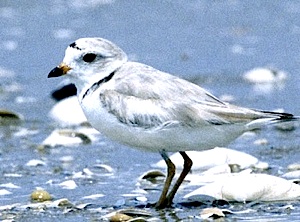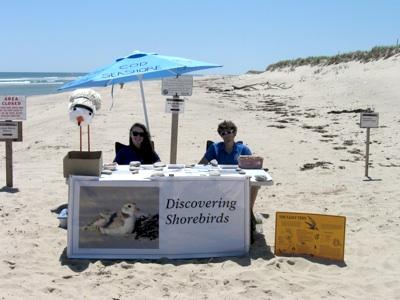Editor's note: In our occasional series of stories examining what interns with the Student Conservation Association are up to, we caught up with Theresa Conn, who spent time at Cape Cod National Seashore working to protect piping plovers, their nests, eggs, and fledglings. Here's a look at her experience.
It was early morning on Cape Cod National Seashore. I was walking cautiously along the beach with three shorebird biologists trained in avian behaviors. We were looking for signs of piping plovers, which are federally threatened shorebirds that nest all over Cape Cod.
It was my ninth day at work as a Shorebird Conservation Intern, and already I felt like I knew what I was doing. However, it was early, and I felt my mind drifting.
“Theresa, freeze!” yelled Dennis, my supervisor. Like a child playing a game, I stiffened immediately without even a thought. My right foot was raised in the air, only inches above the ground.
“Do you see it? You’re pretty close to a scrape,” Dennis said, both chastising and understanding.
I looked around but saw nothing. Finally, I spied the small, sand-colored piping plover egg lying in a hidden nest in the ground, about five feet away. At that point, I realized how easy it would be for someone to step on a nearly invisible nest by accident. After all, piping plovers, shorebirds that are fighting extinction, have a hard enough time staying alive without me crushing their eggs.
Piping Plover Boot Camp
My first month on the Cape was essentially "piping plover boot camp." I shadowed shorebird techs as they traveled the beach looking for birds, nests, and eggs. I found scrapes (nests) on my own, watched adorable chicks stumble around the beach, and sledge-hammered six-foot fencing posts into the sand.
The underlying reason for the plover’s decline on the East Coast has been the growing number of people visiting the coastline.

A piping plover. USFWS photo.
On Cape Cod, habitat loss has also been a primary problem, with increasing shoreline development and tourism. The presence of people near plover nesting areas may cause the birds to abandon their nests, exposing their eggs to the hot sun and predators.
Many predator populations have increased by taking advantage of human-provided foods. The more people that go to the beach, the more trash there is; the more trash there is, the more crows and coyotes there are. This has resulted in unnaturally high predation pressure to nests, chicks, and adults.
Beginning in May, field technicians all over the East Coast go out to the beach daily looking for tracks, birds, and scrapes (nests). Once a scrape is found, the shorebird team erects fencing to warn the public that they are near a nesting area. To protect the plovers from predation, exclosures are put up around nests. Exclosures are essentially flexible cages that allow plovers to come and go from their nests as they please but keep out predators.
Educating The Public
One of their biggest problems has been public outrage about conservation practices. From early March to mid-August, areas of the beach may be closed off for recreation to accommodate shorebird nesting. This can be very frustrating for some beachgoers. Some adults will disregard the fencing and continue walking, putting eggs and plover chicks in danger. In extreme circumstances, such as with repeat offenders, we get help from the park rangers.
Fortunately, it rarely gets to that point. Kids, on the other hand, are fun and receptive. I’ll never forget the look of awe in a child’s eyes when they hold an abandoned plover egg. In an age of computers and video games, young people rarely get the chance to step outside and really experience the world around them.
National parks are vital for this reason; each park is a small oasis of nature where kids can unplug. Whether it’s searching for minuscule piping plover eggs at Cape Cod National Seashore or scaling Half Dome at Yosemite, the National Park System offers invaluable experiences for young people.
One of the most common questions asked is, “What do the piping plovers do for me?” In abstract, it would appear that the answer is nothing. The disappearance of the little birds on Cape Cod beaches would go unnoticed by the average beachgoer. However, in reality, piping plovers are canaries in the coal mine. The gradual disappearance of the piping plover population is an indication that our human presence on Cape Cod National Seashore has had a negative impact on the environment.
At what point do we intervene and right our wrongs? If we let the plovers go extinct, what species is next?
My time with SCA on Cape Cod has redirected and shaped my future career goals. I grew up with a desire to be a teacher, but I didn’t want to live my entire life in a classroom. I’ve now learned that teachers come in all different forms, and that nature is one of our best classrooms.
Traveler footnote: A version of this article was originally published by Inquiry, the online undergraduate research journal of the University of New Hampshire.




Comments
I agree that the preditors are the problem at this point, but that is politcal. An EA needs to be filed to properly control the preditors that we, as humans, have influenced over a couple of centuries. The crows would not be around the beach if beach vistors would not leave food around, and the coyotes would not be so abuntant if we did not hunt all the wolves to local extintion. Before all the fencing went, humans were the main impact to this species. The eggs look like rocks and without a trained eye people stepped on the nest, hence the fencing. I hope this helps a little more and if you want to read more there are plenty of science journals about plovers on Google Scholar.
and if the ice age and a meteor did not happen then the dinosaurs would eat plovers every day... Nice fairy tale.
ps it is not just fencing it is 1000 meter buffers in all directions in some locations.
If an ice age and meteors were caused by humans, you'd have a point. Otherwise, you're completely missing the early anon's point.
ProveProve the plovers are not being eaten by ghost crabs!